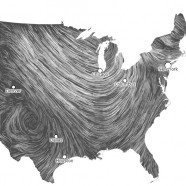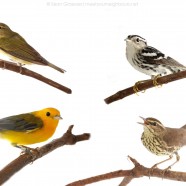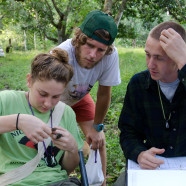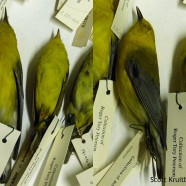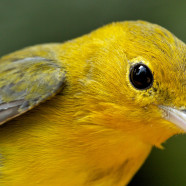Rarities on the Wing
I took this screenshot late this morning via this always helpful and very cool wind map. They use surface wind data from the National Digital Forecast Database, updated hourly, to create this national flow of air. Even without it in motion you can see there is a huge trough in the east, with winds shooting down from the northwest until you get to about Chicago, at which point the bend brings them screaming out of the south and then the east higher into New England. All of this unsettled weather can easily push avian migrants out of their chosen path, bringing southern resident rarities up to...
Read MoreThe Four MoSI Warblers
The 2014-15 MoSI, or Monitoreo de Sobrevivencia Invernal (Monitoring of Winter Survivorship), protocol banding season for the Nicoya Peninsula Avian Research Station is now in the books. Here we have four species, in the form of Neotropical migratory warblers, that were banded and recaptured over the years at the station: the Tennessee Warbler (Oreothlypis peregrina), Black-and-white Warbler (Mniotilta varia), Prothonotary Warbler (Protonotaria citrea), and Northern Waterthrush (Parkesia noveboracen). Banding research is critical to gain an understanding of where and why they return to...
Read MoreNicoya Peninsula Avian Research Station seeking volunteers
The Nicoya Peninsula Avian Research Station is seeking volunteer banding technicians for a winter project in northwestern Costa Rica. The research is aimed toward the study of molt and aging criteria in Costa Rican resident bird species, and collection of data from wintering Nearctic-Neotropical migrants for the Institute for Bird Populations’ MoSI Program. Winter participants will aid in the operation of four bird banding sites on the Nicoya Peninsula. These positions are opportunities for students, educators, amateur or professional ornithologists, and nature enthusiasts to visit one of...
Read MoreRTPI’s avian archives
RTPI’s extensive archives hold a massive collection of bird study skins. This includes several extinct species as well like the Passenger Pigeon, Ivory-billed Woodpecker, Carolina Parakeet, and Bachman’s Warbler. I looked through hundreds of warblers yesterday while I was answering a couple of questions for myself after the busy last few weeks of spring migration. I was struck by this size differential – Prothonotary Warbler vs. Wilson’s Warbler. We “know” their respective sizes but…geez! The Wilson’s Warbler on the right with the black cap...
Read MoreProthonotary Warbler (Protonotaria citrea) recapture by Sean Graesser
This Prothonotary Warbler was originally banded in 2011 as a bird of at least two years of age. We recaptured this bird this year at our site. This mean the bird has traveled at least 27,000 miles so far in his life. It has returned to the same site in a Mangrove estuary in Costa Rica now for three years. It always amazes me to think about the incredible journeys these songbirds make and the need to preserve the habitat on both ends of their life cycles.
Read More



